Effect of Straw Mulch on Soil Evaporation during Freeze–Thaw Periods
Abstract
1. Introduction
2. Materials and Methods
2.1. Field Station
2.2. Experiment Design
2.3. Calculation of Soil Evaporation
3. Results
3.1. Soil Freezing and Thawing Process
3.2. Soil Evaporation Characteristics during Three Freeze–Thaw Stages
3.2.1. Unstable Freezing Stage
3.2.2. Stable Freezing Stage
3.2.3. Thawing Stage
3.3. Cumulative Soil Evaporation during the Freeze–Thaw Period
3.4. Major Factors Influencing Soil Evaporation in Different Freeze–Thaw Stages
3.4.1. Principal Component Analysis
3.4.2. Unstable Freezing Stage
3.4.3. Stable Freezing Stage
3.4.4. Thawing Stage
4. Conclusions
Author Contributions
Funding
Acknowledgments
Conflicts of Interest
References
- Li, Y.; Liu, H.; Huang, G. Modeling resistance of soil evaporation and soil evaporation under straw mulching. Trans. Chin. Soc. Agric. Eng. 2015, 31, 98–106. [Google Scholar]
- Zribi, W.; Aragüés, R.; Medina, E.; Faci, J.M. Efficiency of inorganic and organic mulching materials for soil evaporation control. Soil Tillage Res. 2015, 148, 40–45. [Google Scholar] [CrossRef]
- Jalota, S.K. Evaporation through a soil mulch in relation to mulch characteristics and evaporativity. Aust. J. Soil Res. 1993, 31, 131–136. [Google Scholar] [CrossRef]
- Li, R.; Shi, H.; Flerchinger, G.N.; Akae, T.; Wang, C. Simulation of freezing and thawing soils in Inner Mongolia Hetao Irrigation District, China. Geoderma 2012, 173, 28–33. [Google Scholar] [CrossRef]
- Li, S.X.; Wang, Z.H.; Li, S.Q.; Gao, Y.J.; Tian, X.H. Effect of plastic sheet mulch, wheat straw mulch, and maize growth on water loss by evaporation in dry land areas of China. Agric. Water Manag. 2013, 116, 39–49. [Google Scholar] [CrossRef]
- Hou, X.; Wang, F.; Han, J.; Kang, S.; Feng, S. Duration of plastic mulch for potato growth under drip irrigation in an arid region of Northwest China. Agric. Meteorol. 2010, 150, 115–121. [Google Scholar] [CrossRef]
- Díaz, F.; Jiménez, C.C.; Tejedor, M. Influence of the thickness and grain size of tephra mulch on soil water evaporation. Agric. Water Manag. 2005, 74, 47–55. [Google Scholar] [CrossRef]
- Yuan, C.; Lei, T.; Mao, L.; Liu, H.; Wu, Y. Soil surface evaporation processes under mulches of different sized gravel. Catena 2009, 78, 117–121. [Google Scholar] [CrossRef]
- Chen, H.; Liu, J.; Zhang, A.; Chen, J.; Cheng, G.; Sun, B.; Pi, X.M.; Dyck, M.; Si, B.C.; Zhao, Y. Effects of straw and plastic film mulching on greenhouse gas emissions in Loess Plateau, China: A field study of 2 consecutive wheat-maize rotation cycles. Sci. Total Environ. 2016, 579, 814–824. [Google Scholar] [CrossRef]
- Li, Q.; Chen, Y.H.; Liu, M.Y.; Zhou, X.B.; Yu, S.L.; Dong, B.D. Effects of irrigation and straw mulching on microclimate characteristics and water use efficiency of winter wheat in north china. Plant Prod. Sci. 2008, 11, 161–170. [Google Scholar] [CrossRef]
- Unger, P.W. Evaporation reduction from soil with wheat, sorghum and cotton residue. Soil Sci. Soc. Am. J. 1976, 40, 938–942. [Google Scholar] [CrossRef]
- Jalota, S.K.; Prihar, S.S. Effect of straw mulch on evaporation reduction in relation to rates of mulching and evaporativity. J. Indian Soc. Soil Sci. 1990, 38, 728–730. [Google Scholar]
- Chen, S.; Chen, S.Y.; Zhang, X.Y.; Pei, D.; Sun, H.Y.; Chen, S.L. Effects of straw mulching on soil temperature, evaporation and yield of winter wheat: Field experiments on the North China Plain. Ann. Appl. Biol. 2010, 150, 261–268. [Google Scholar] [CrossRef]
- Lu, P.; Zhang, Z.; Feng, G.; Wan, C.; Shi, X. Effect of straw draining piece depth in soil on water-salt distribution in saline soil and its drainage-salt inhibiting performance. Trans. Chin. Soc. Agric. Eng. 2017, 33, 115–121. [Google Scholar]
- Zribi, W.; Faci, J.M.; Aragues, R. Mulching effects on moisture, temperature, structure and salinity of agricultural soils. Itea-Inf. Tec. Econ. Agrar. 2011, 107, 148–162. [Google Scholar]
- Doring, T.F.; Brandt, M.; Hes, J.; Finckh, M.R.; Saucke, H. Effects of straw mulch on soil nitrate dynamics, weeds, yield and soil erosion in organically grown potatoes. Field Crop. Res. 2005, 94, 238–249. [Google Scholar] [CrossRef]
- Huang, Y.; Chen, L.; Fu, B.; Huang, Z.; Gong, J. The wheat yields and water-use efficiency in the Loess Plateau: Straw mulch and irrigation effects. Agric. Water Manag. 2005, 72, 209–222. [Google Scholar] [CrossRef]
- Zhang, S.; Lovdahl, L.; Grip, H.; Jansson, P.; Tong, Y. Modelling the effects of mulching and fallow cropping on water balance in the Chinese Loess Plateau. Soil Tillage Res. 2007, 93, 283–298. [Google Scholar] [CrossRef]
- Chakraborty, D.; Garg, R.N.; Tomar, R.K.; Singh, R.; Sharma, S.K.; Singh, R.K.; Trivedi, S.M.; Mittal, R.B.; Sharma, P.K.; Kamble, K.H. Synthetic and organic mulching and nitrogen effect on winter wheat (Triticum aestivum L.) in a semi-arid environment. Agric. Water Manag. 2010, 97, 738–748. [Google Scholar] [CrossRef]
- Fu, X.; Wang, W.; Sainju, U.M.; Zhao, F.Z.; Liu, W.Z. Soil microbial community and carbon and nitrogen fractions responses to mulching under winter wheat. Appl. Soil Ecol. 2019, 139, 64–68. [Google Scholar] [CrossRef]
- Ram, H. Grain yield and water use efficiency of wheat (Triticum aestivum L.) in relation to irrigation levels and rice straw mulching in North West India. Agric. Water Manag. 2013, 128, 92–101. [Google Scholar] [CrossRef]
- Ramakrishna, A.; Tam, H.M.; Wani, S.P.; Long, T.D. Effect of mulch on soil temperature, moisture, weed infestation and yield of groundnut in northern Vietnam. Field Crop. Res. 2006, 95, 115–125. [Google Scholar] [CrossRef]
- Rahman, M.A.; Chikushi, J.; Saifizzaman, M.; Lauren, J.G. Rice straw mulching and nitrogen response of no-till wheat following rice in bangladesh. Field Crop. Res. 2005, 91, 71–81. [Google Scholar] [CrossRef]
- Singh, B.; Humphreys, E.; Eberbach, P.L.; Katupitiya, A.; Singh, Y.; Kukal, S.S. Growth, yield and water productivity of zero till wheat as affected by rice straw mulch and irrigation schedule. Field. Crop. Res. 2011, 121, 209–225. [Google Scholar] [CrossRef]
- Cao, J.; Liu, C.; Zhang, W.; Guo, Y. Effect of integrating straw into agricultural soils on soil infiltration and evaporation. Water Sci. Technol. 2012, 65, 2213–2218. [Google Scholar] [CrossRef] [PubMed]
- Chen, J.F.; Zheng, X.Q.; Zang, H.F. Effects of irrigation on soil temperature and soil freeze-thaw characteristics during seasonal freeze-thaw period. Trans. Chin. Soc. Agric. Mach. 2013, 44, 104–109. [Google Scholar]
- Singh, B.; Eberbach, P.L.; Humphreys, E.; Kukal, S.S. The effect of rice straw mulch on evapotranspiration, transpiration and soil evaporation of irrigated wheat in punjab, India. Agric. Water Manag. 2011, 98, 1847–1855. [Google Scholar] [CrossRef]
- Cai, T.; Zhang, C.; Huang, Y.; Huang, H.; Jia, Z. Effects of different straw mulch modes on soil water storage and water use efficiency of spring maize (Zea mays L.) in the Loess Plateau of China. Plant. Soil Environ. 2015, 61, 253–259. [Google Scholar] [CrossRef]
- Zhang, S.; Yang, X.; Lovdahl, L. Soil management practice effect on water balance of a dry land soil during fallow period on the Loess Plateau of China. Soil Water Res. 2016, 11, 64–73. [Google Scholar] [CrossRef]
- Li, S.; Li, Y.; Lin, H.; Feng, H.; Dyck, M. Effects of different mulching technologies on evapotranspiration and summer maize growth. Agric. Water Manag. 2017, 201, 309–318. [Google Scholar] [CrossRef]
- Zhao, H.B.; Liu, J.F.; Chen, X.W.; Wang, Z.H. Straw mulch as an alternative to plastic film mulch: Positive evidence from dryland wheat production on the Loess Plateau. Sci. Total Environ. 2019, 676, 782–791. [Google Scholar] [CrossRef] [PubMed]
- Bunna, S.; Sinath, P.; Makara, O.; Mitchell, J.; Fukai, S. Effects of straw mulch on mungbean yield in rice fields with strongly compacted soils. Field Crop. Res. 2011, 124, 295–301. [Google Scholar] [CrossRef]
- Xu, X.Z.; Wang, J.C.; Zhang, L.X. Frozen Soil Physics; Science Press: Beijing, China, 2001. [Google Scholar]
- Yi, J.; Zhao, Y.; Shao, M.A.; Zhang, J.; Cui, L.; Si, B. Soil freezing and thawing processes affected by the different landscapes in the middle reaches of Heihe River Basin, Gansu, China. J. Hydrol. 2014, 519, 1328–1338. [Google Scholar] [CrossRef]
- Zhao, Y.; Huang, M.; Horton, R.; Liu, F.; Peth, S.; Horn, R. Influence of winter grazing on water and heat flow in seasonally frozen soil of Inner Mongolia. Vadose Zone J. 2013, 12, 1–11. [Google Scholar] [CrossRef]
- Chen, J.F.; Zheng, X.Q.; Qin, Z.D.; Liu, P.; Zang, H.F.; Sun, M. Effects of maize straw mulch on spatiotemporal variation of soil profile moisture and temperature during freeze-thaw period. Trans. Chin. Soc. Agric. Eng. 2013, 29, 102–110. [Google Scholar]
- Fu, Q.; Yan, P.R.; Li, T.X.; Cui, S.; Peng, L. Effects of straw mulching on soil evaporation during the soil thawing period in a cold region in northeastern China. J. Earth Syst. Sci. 2018, 127, 33. [Google Scholar] [CrossRef]
- Fuchs, M.; Hadas, A. Mulch resistance to water vapor transport. Agric. Manag. Water 2011, 98, 990–998. [Google Scholar] [CrossRef]
- Feng, H.; Chen, J.; Zheng, X.; Xue, J.; Miao, C.; Du, Q.; Xu, Y. Effect of sand mulches of different particle sizes on soil evaporation during the freeze–thaw period. Water 2018, 10, 536. [Google Scholar] [CrossRef]
- Chen, J.F.; Gao, X.G.; Zheng, X.Q.; Miao, C.Y.; Liu, P.; Du, Q.; Xu, Y.X. Transformation between phreatic water and soil water during freeze–thaw periods. Water 2018, 10, 376. [Google Scholar] [CrossRef]
- Miao, C.Y.; Chen, J.F.; Zheng, X.Q.; Zhang, Y.B.; Xu, Y.X.; Du, Q. Soil Water and phreatic evaporation in shallow groundwater during a freeze–thaw period. Water 2017, 9, 396. [Google Scholar] [CrossRef]
- Longobardi, A.; Khaertdinova, E. Relating soil moisture and air temperature to evapotranspiration fluxes during inter-storm periods at a Mediterranean experimental site. J. Arid Land 2015, 7, 27–36. [Google Scholar] [CrossRef]
- Santos, J.S.; Oliveira, E.; Bruns, R.E.; Gennari, R.F. Evaluation of the salt accumulation process during inundation in water resource of Contas river basin (Bahia–Brazil) applying principal component analysis. Water Res. 2004, 38, 1579–1585. [Google Scholar] [CrossRef] [PubMed]
- Cadavid, A.C.; Lawrence, J.K.; Ruzmaikin, A. Principal Components and independent component analysis of solar and space data. Sol. Phys. 2008, 248, 247–261. [Google Scholar] [CrossRef][Green Version]
- Meng, L.; Zuo, R.; Wang, J.S.; Yang, J.; Teng, Y.G.; Shi, R.T.; Zhai, Y.Z. Apportionment and evolution of pollution sources in a typical riverside groundwater resource area using PCA-APCS-MLR model. J. Contam. Hydrol. 2018, 218, 70–83. [Google Scholar] [CrossRef] [PubMed]
- Garcia, D.P.; Caraschi, J.C.; Ventorim, G.; Vieira, F.H.; Protasio, T.D. Assessment of plant biomass for pellet production using multivariate statistics (PCA and HCA). Renew. Energy 2019, 139, 796–805. [Google Scholar] [CrossRef]
- Uddin, M.N.; Islam, A.K.; Bala, S.K.; Islam, G.M.; Adhikary, S.; Saha, D.; Akter, R. Mapping of climate vulnerability of the coastal region of Bangladesh using principal component analysis. Appl. Geogr. 2019, 102, 47–57. [Google Scholar] [CrossRef]
- Davarzani, H.; Smits, K.; Tolene, R.M.; Illangasekare, T. Study of the effect of wind speed on evaporation from soil through integrated modeling of the atmospheric boundary layer and shallow subsurface. Water Resour. Res. 2014, 50, 661–680. [Google Scholar] [CrossRef]
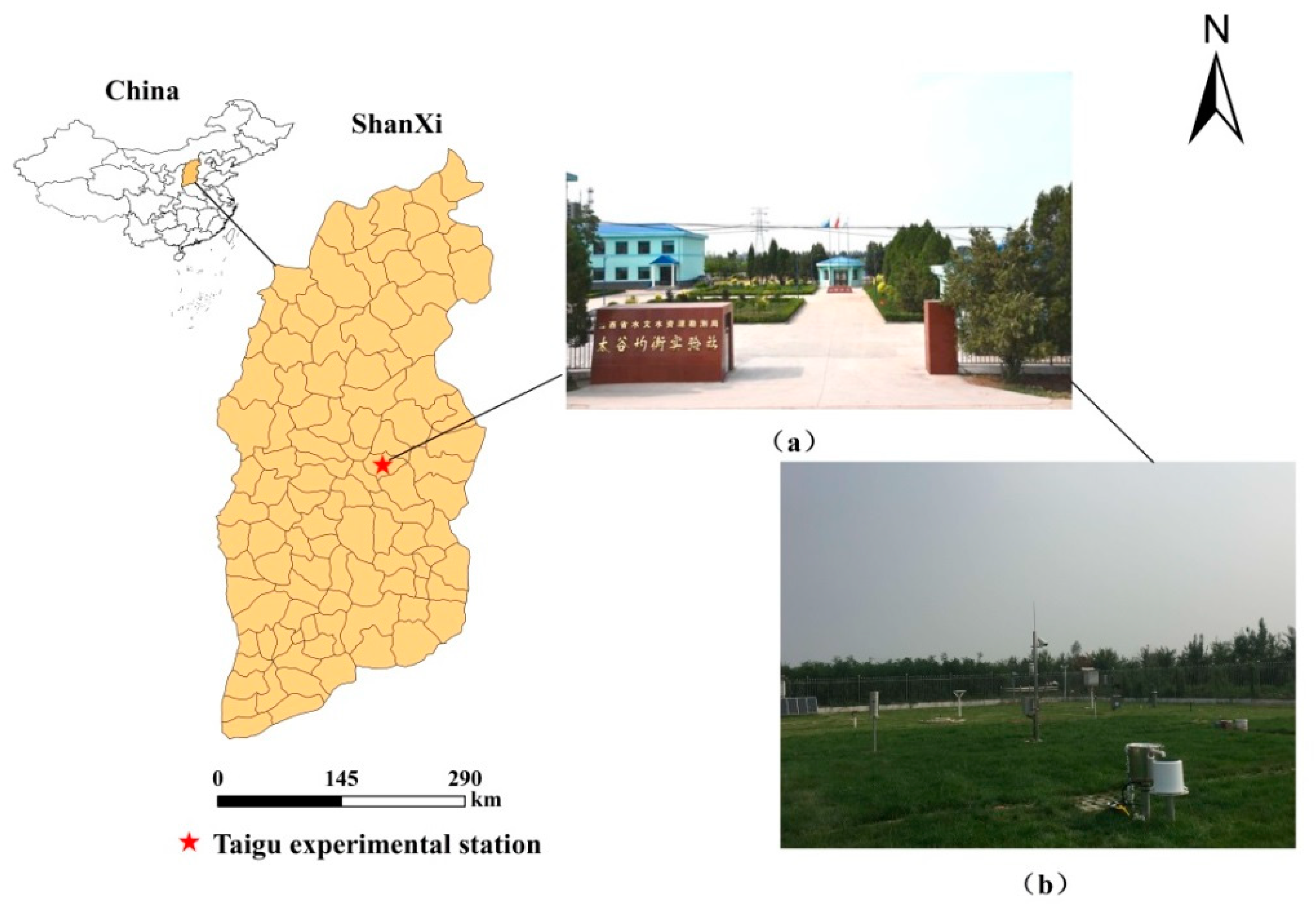
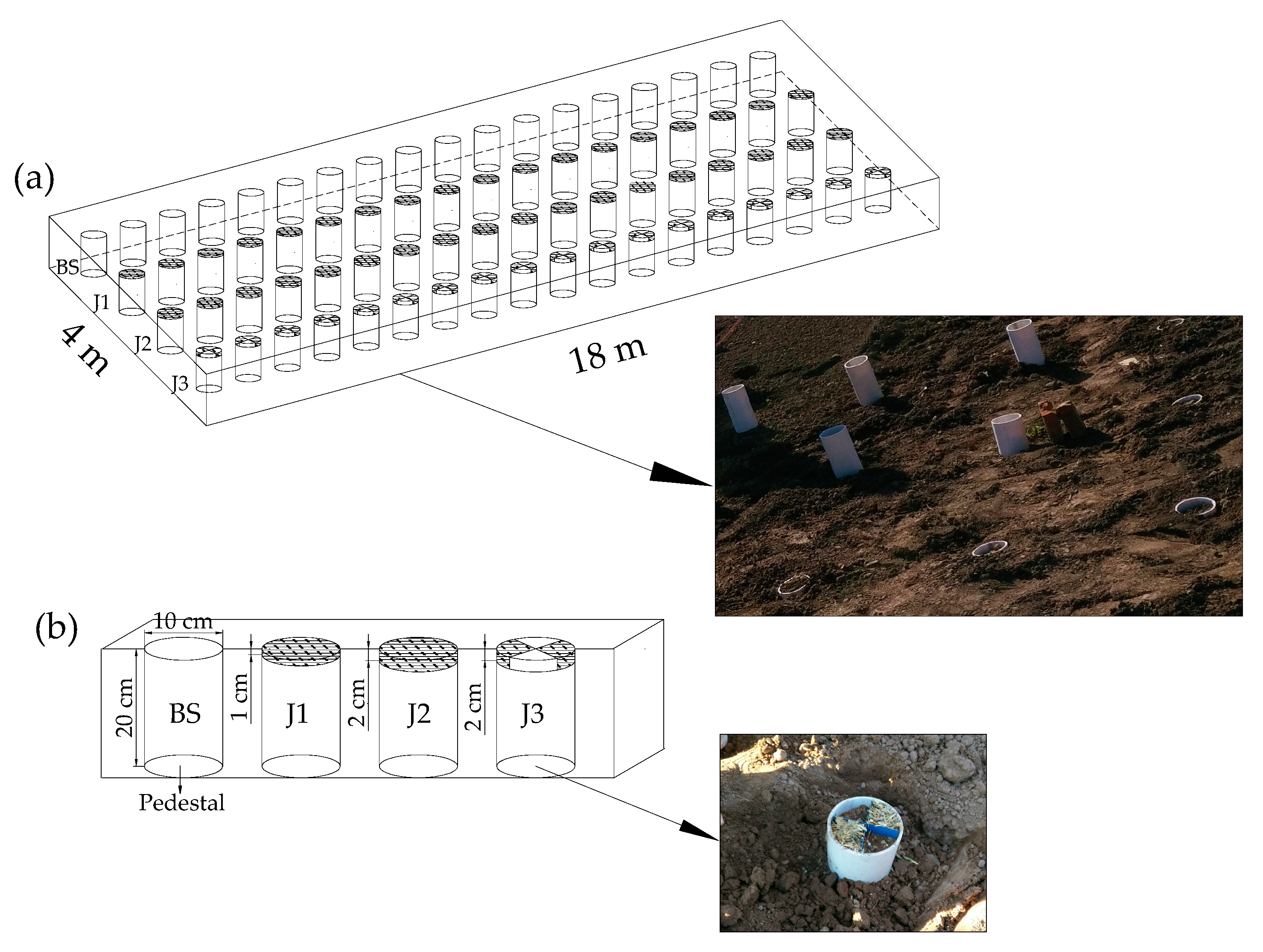
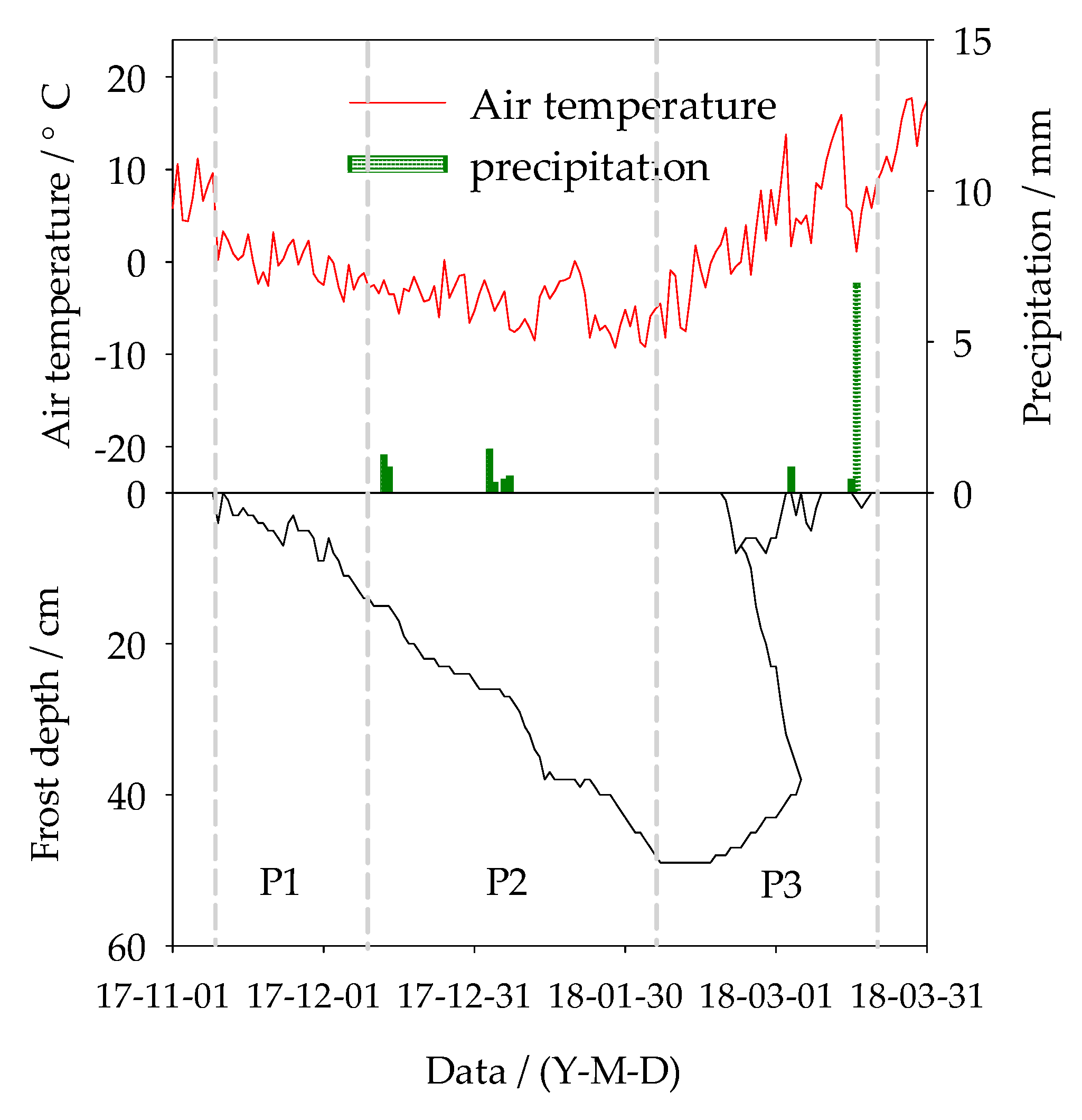

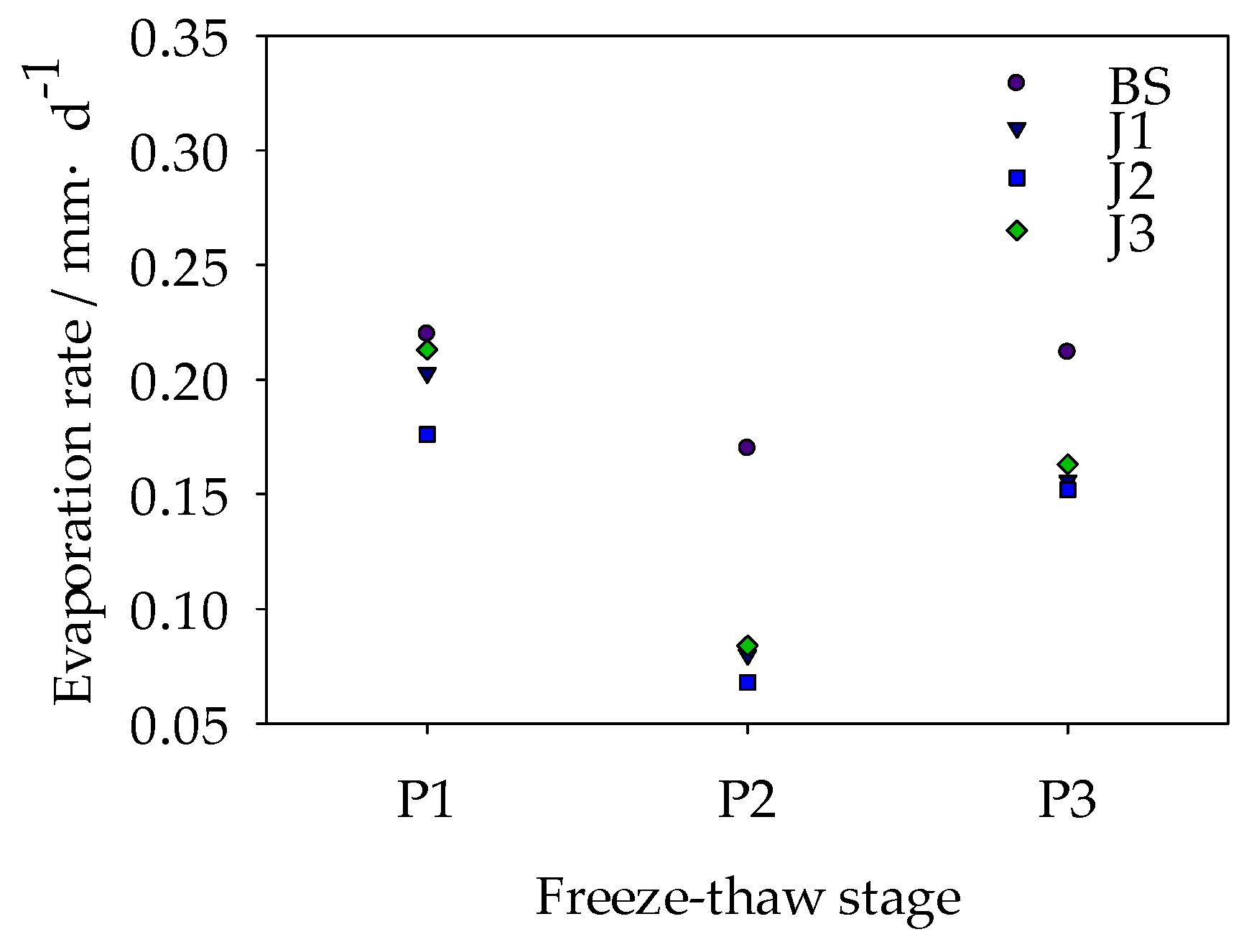

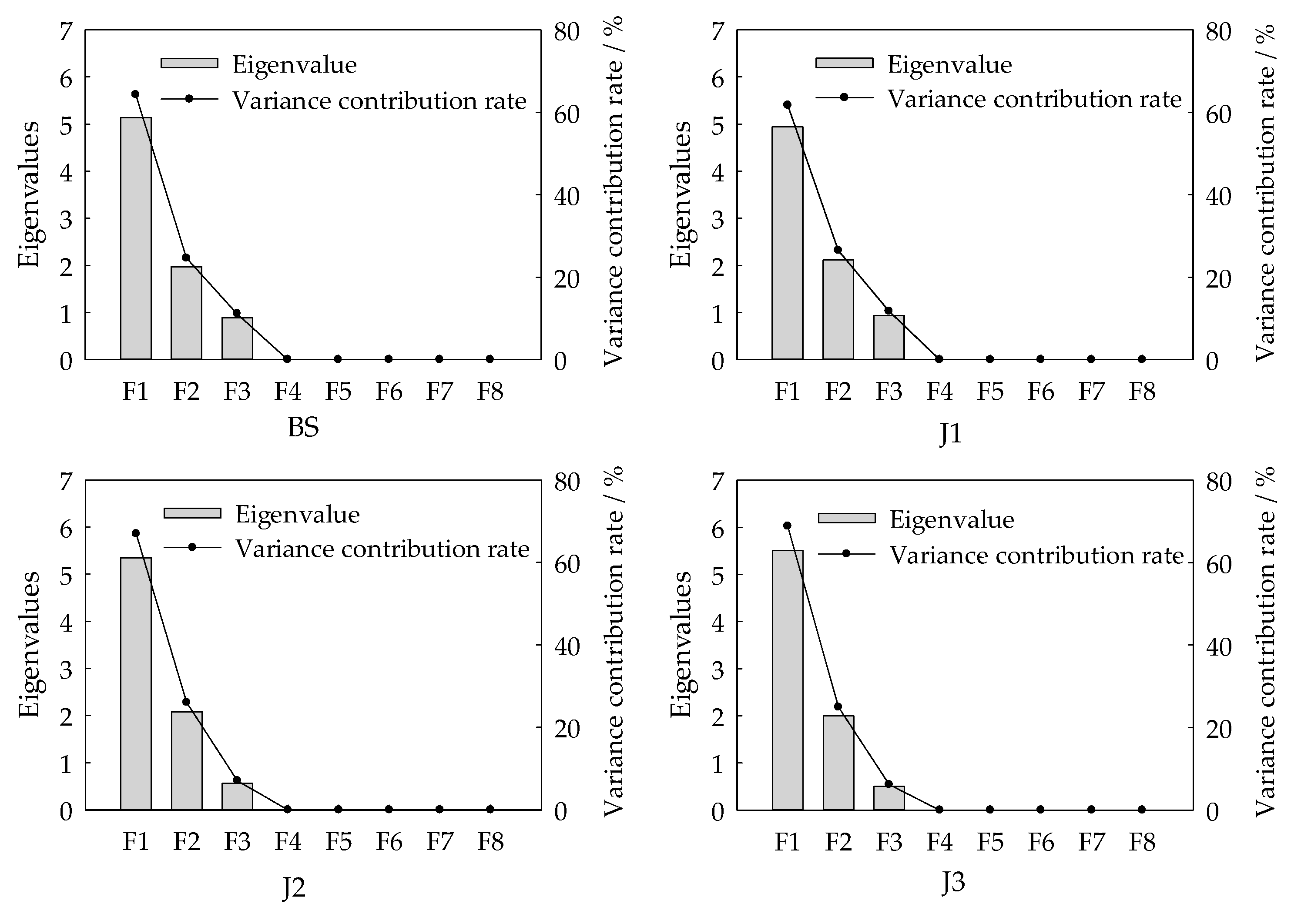
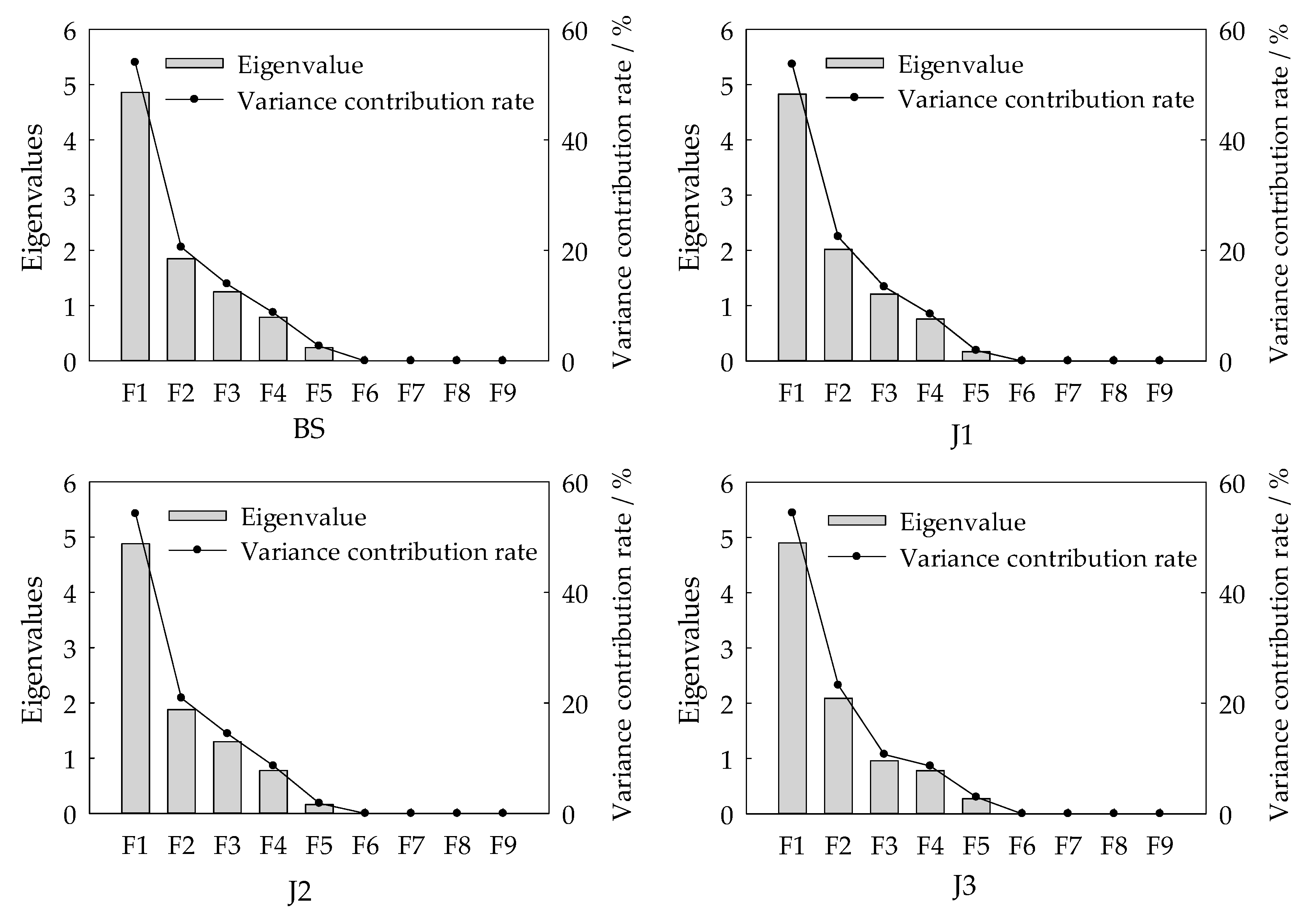
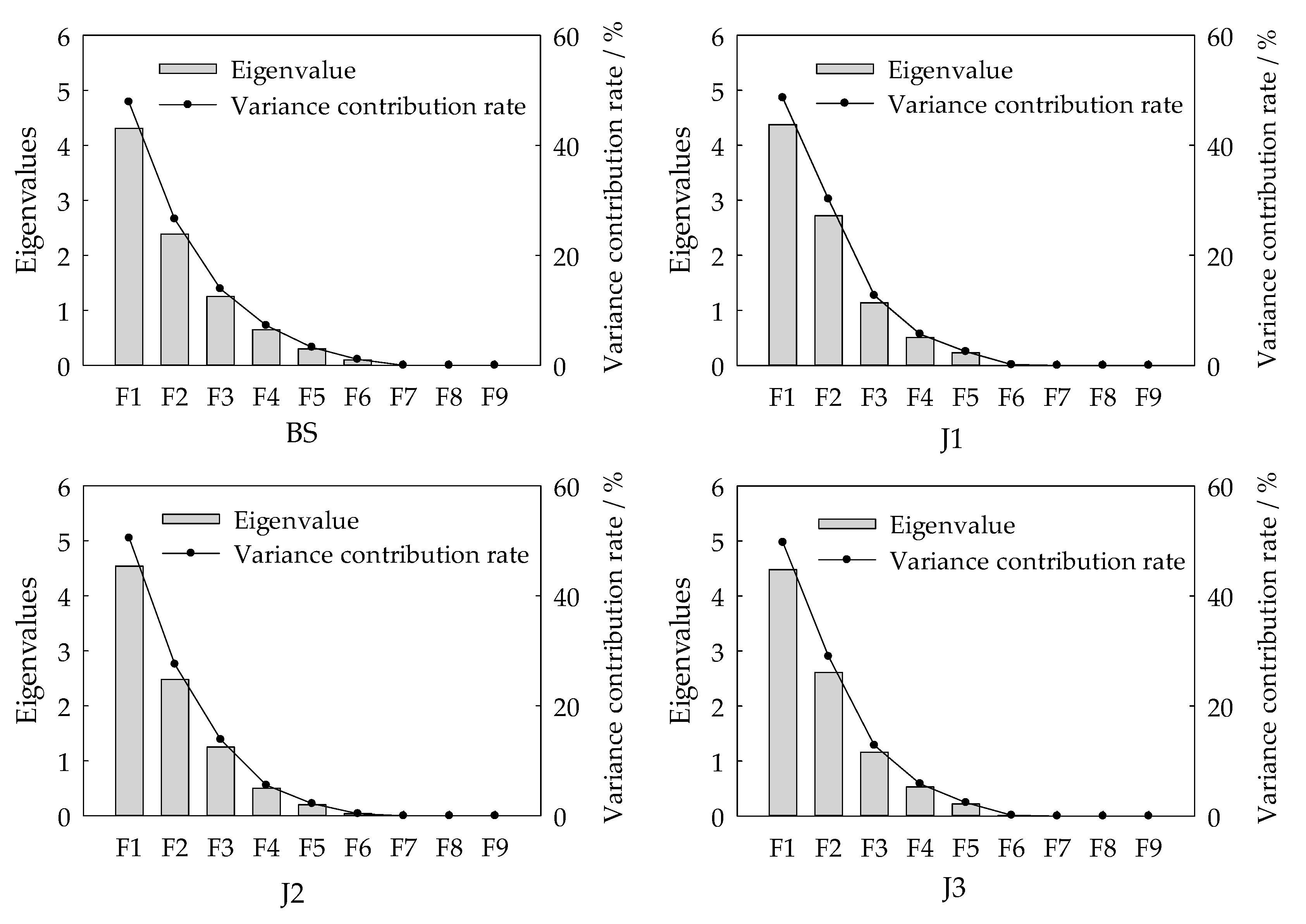
| Soil Depth (cm) | Bulk Density (g·cm−3) | Particle Size Distribution | ||
|---|---|---|---|---|
| Clay (%) | Silt (%) | Sand (%) | ||
| 0–30 | 1.41 | 0.82 | 9.07 | 91.22 |
| 30–60 | 1.41 | 1.27 | 14.84 | 86.61 |
| 60–80 | 1.41 | 0.88 | 13.46 | 90.55 |
| 80–100 | 1.41 | 0.41 | 7.06 | 95.57 |
| Treatment | E = a + bt | E = aebt | E = atb | ||||||
|---|---|---|---|---|---|---|---|---|---|
| a | b | R2 | a | b | R2 | A | b | R2 | |
| BS | 1.765 | 0.162 | 0.97 | 3.487 | 0.016 | 0.87 | 0.378 | 0.841 | 0.99 |
| J1 | 1.989 | 0.099 | 0.96 | 3.001 | 0.013 | 0.86 | 0.473 | 0.700 | 0.98 |
| J2 | 1.433 | 0.093 | 0.97 | 2.549 | 0.014 | 0.88 | 0.388 | 0.719 | 0.98 |
| J3 | 2.101 | 0.104 | 0.96 | 3.141 | 0.013 | 0.84 | 0.484 | 0.707 | 0.98 |
| Factors | Treatment | |||
|---|---|---|---|---|
| BS | J1 | J2 | J3 | |
| solar radiation (x1) | 0.27 | 0.25 | 0.3 | 0.25 |
| air temperature (x2) | 0.37 | 0.39 | 0.39 | 0.35 |
| surface soil temperature (x3) | 0.43 | 0.44 | 0.42 | 0.41 |
| surface soil water content (x4) | −0.29 | 0.2 | 0.34 | 0.38 |
| wind speed (x5) | 0.3 | 0.27 | 0.25 | 0.29 |
| vapor pressure (x6) | 0.35 | 0.39 | 0.37 | 0.34 |
| relative humidity (x7) | −0.38 | −0.38 | −0.35 | −0.37 |
| precipitation (x8) | / | / | / | / |
| water surface evaporation (x9) | 0.41 | 0.43 | 0.39 | 0.4 |
| Factors | Treatment | |||
|---|---|---|---|---|
| BS | J1 | J2 | J3 | |
| solar radiation (x1) | 0.41 | 0.41 | 0.43 | 0.4 |
| air temperature (x2) | −0.23 | −0.22 | −0.26 | −0.19 |
| surface soil temperature (x3) | 0.19 | 0.19 | 0.16 | 0.22 |
| surface soil water content (x4) | −0.33 | −0.34 | −0.36 | −0.35 |
| wind speed (x5) | 0.42 | 0.4 | 0.41 | 0.4 |
| vapor pressure (x6) | 0.32 | 0.3 | 0.34 | 0.3 |
| relative humidity (x7) | −0.42 | −0.42 | −0.40 | −0.42 |
| precipitation (x8) | −0.18 | −0.21 | −0.16 | −0.20 |
| water surface evaporation (x9) | 0.39 | 0.4 | 0.37 | 0.41 |
| Factors | Treatment | |||
|---|---|---|---|---|
| BS | J1 | J2 | J3 | |
| solar radiation (x1) | 0.45 | 0.45 | 0.42 | 0.43 |
| air temperature (x2) | 0.47 | 0.47 | 0.46 | 0.46 |
| surface soil temperature (x3) | 0.38 | 0.42 | 0.4 | 0.39 |
| surface soil water content (x4) | 0.17 | 0.15 | 0.27 | 0.25 |
| wind speed (x5) | 0.2 | 0.16 | 0.12 | 0.15 |
| vapor pressure (x6) | −0.39 | −0.37 | −0.34 | −0.35 |
| relative humidity (x7) | 0.28 | 0.25 | 0.26 | 0.26 |
| precipitation (x8) | 0.16 | 0.19 | 0.23 | 0.21 |
| water surface evaporation (x9) | 0.33 | 0.35 | 0.36 | 0.35 |
© 2019 by the authors. Licensee MDPI, Basel, Switzerland. This article is an open access article distributed under the terms and conditions of the Creative Commons Attribution (CC BY) license (http://creativecommons.org/licenses/by/4.0/).
Share and Cite
Chen, J.; Xie, X.; Zheng, X.; Xue, J.; Miao, C.; Du, Q.; Xu, Y. Effect of Straw Mulch on Soil Evaporation during Freeze–Thaw Periods. Water 2019, 11, 1689. https://doi.org/10.3390/w11081689
Chen J, Xie X, Zheng X, Xue J, Miao C, Du Q, Xu Y. Effect of Straw Mulch on Soil Evaporation during Freeze–Thaw Periods. Water. 2019; 11(8):1689. https://doi.org/10.3390/w11081689
Chicago/Turabian StyleChen, Junfeng, Xue Xie, Xiuqing Zheng, Jing Xue, Chunyan Miao, Qi Du, and Yongxin Xu. 2019. "Effect of Straw Mulch on Soil Evaporation during Freeze–Thaw Periods" Water 11, no. 8: 1689. https://doi.org/10.3390/w11081689
APA StyleChen, J., Xie, X., Zheng, X., Xue, J., Miao, C., Du, Q., & Xu, Y. (2019). Effect of Straw Mulch on Soil Evaporation during Freeze–Thaw Periods. Water, 11(8), 1689. https://doi.org/10.3390/w11081689







